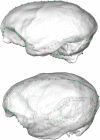Brain shape convergence in the adaptive radiation of New World monkeys
- PMID: 26858427
- PMCID: PMC4776464
- DOI: 10.1073/pnas.1514473113
Brain shape convergence in the adaptive radiation of New World monkeys
Abstract
Primates constitute one of the most diverse mammalian clades, and a notable feature of their diversification is the evolution of brain morphology. However, the evolutionary processes and ecological factors behind these changes are largely unknown. In this work, we investigate brain shape diversification of New World monkeys during their adaptive radiation in relation to different ecological dimensions. Our results reveal that brain diversification in this clade can be explained by invoking a model of adaptive peak shifts to unique and shared optima, defined by a multidimensional ecological niche hypothesis. Particularly, we show that the evolution of convergent brain phenotypes may be related to ecological factors associated with group size (e.g., social complexity). Together, our results highlight the complexity of brain evolution and the ecological significance of brain shape changes during the evolutionary diversification of a primate clade.
Keywords: Platyrrhini; adaptive evolution; comparative method; geometric morphometrics; primates.
Conflict of interest statement
The authors declare no conflict of interest.
Figures









References
-
- Futuyma DJ. 1998. Evolutionary Biology (Sinauer Associates, Sunderland, MA)
-
- Gavrilets S, Losos JB. Adaptive radiation: Contrasting theory with data. Science. 2009;323(5915):732–737. - PubMed
-
- Simpson GG. The Major Features of Evolution. Columbia Univ Press; New York: 1953.
-
- Losos JB. Adaptive radiation, ecological opportunity, and evolutionary determinism. American Society of Naturalists E. O. Wilson Award Address. Am Nat. 2010;175(6):623–639. - PubMed
Publication types
MeSH terms
LinkOut - more resources
Full Text Sources
Other Literature Sources

